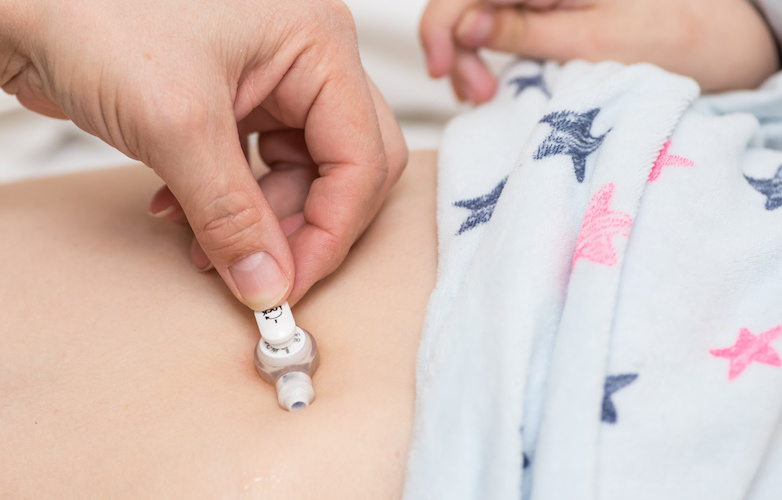Evidence-based guideline reduces G-tube placement in young patients

Gastrostomy tubes (G-tubes) are commonly used to deliver nutrition directly to the stomach in patients who cannot eat by mouth, require supplemental nutrients, or have swallowing difficulties, including oropharyngeal dysphagia with aspiration. While the placement of G-tubes is on the rise nationally, data suggests that children with G-tubes have two to three times the number of hospitalizations as those who can be fed orally. While intended to improve quality of life, G-tubes may have unforeseen consequences, including an increased risk of postsurgical complications and higher overall medical costs.
To address these concerns, Maireade McSweeney, MD, MPH; Rachel Rosen, MD, MPH; and their colleagues in the Aerodigestive Center at Boston Children’s Hospital created a first-of-its-kind evidence-based guideline to aid gastroenterologists in the evaluation of aspirating patients 2 years old or younger. “Our goal was to encourage oral feeding and decrease the use of G-tube placement by 10 percent within a year,” says Rosen.
Their analysis of the guideline’s effectiveness was published in the January 29, 2020, issue of Pediatrics.
A first-of-its-kind guideline
The aerodigestive team developed this guideline through a review of the literature, along with input from clinicians in quality improvement, motility, general gastroenterology, and speech language pathology. They began implementing the guideline in January 2015.
The guideline applies to all Boston Children’s patients age 2 and younger who show evidence of aspiration on a video fluoroscopic swallow study (VFSS). It stresses the importance of obtaining a VFSS in any patient with suspected aspiration and doing a trial of thickened liquids or nasogastric tube (NG) feedings before deciding to place a G-tube.
“This guideline is a great example of how one quality improvement initiative could truly lead to appreciable differences in patient care,” says McSweeney. “Through the implementation of this guideline we were able to standardize the initial gastrointestinal evaluation for patients presenting with feeding difficulties prior to moving ahead with a G-tube.”
A dramatic decrease in G-tube placement
From the launch of the guideline until September 2018, 1,231 patients underwent VFSS, of which 36 percent were found to have aspiration or penetration noted on an initial VFSS. At the beginning of the guideline implementation, G-tube placement in this population was 11.2 percent. This number fell to just 5.8 percent within a year of guideline implementation, an improvement that was sustained over the next two years.
Importantly, patients who were orally fed did not have greater morbidity as a result. For example, patients who didn’t undergo G-tube placement had on average only 0.3 visits to the emergency department (ED) over six months following the initial swallow study. In comparison, children who did have a G-tube placed had 1.5 ED visits during the same time period. By far, the most common reason for ED visits in this group was G-tube malfunction.
Addressing barriers to oral feeding
Because fear of increased pulmonary exacerbations is a barrier to continuing oral feeding for many providers, the aerodigestive team implemented additional supports for these clinicians. For example, when a patient was diagnosed with aspiration via VFSS, members of the aerodigestive team discussed the diagnosis and arranged for direct admission to the inpatient gastroenterology service, where attendings had all been educated on the importance of trying to initially maintain NG and oral feeding rather than G-tube placement. A team of specially trained nurse practitioners was also formed to encourage oral feeding and NG-tube placement within two weeks of hospital discharge when possible. Finally, if clinicians felt uncomfortable with oral feeding, patients could be transferred to the care of the Aerodigestive Center.
As a result of these changes, the aerodigestive team was able to successfully reduce the use of G-tube placement by almost half, sustaining that reduction for the next two years. The study also suggests a benefit of cost savings for families: The researchers found a nine-fold difference in total costs between patients treated with G-tubes versus those who were not.
“Fundamentally, every parent wants their child to eat by mouth,” says Rosen. “This study provides important evidence that this can be done safely without feeding tubes in a significant proportion of patients. We are hopeful that this algorithm can be adopted by other hospitals nationally to encourage oral feeding and reduce morbidity often associated with gastrostomy tubes.”
Learn about the Aerodigestive Center.
Related Posts :
-

Parsing the promise of inosine for neurogenic bladder
Spinal cord damage — whether from traumatic injury or conditions such as spina bifida — can have a profound impact on bladder ...
-

Unveiling the hidden impact of moyamoya disease: Brain injury without symptoms
Moyamoya disease — a rare, progressive condition that narrows the brain’s blood vessels — leads to an increased risk of stroke ...
-

Forecasting the future for childhood cancer survivors
Children are much more likely to survive cancer today than 50 years ago. Unfortunately, as adults, many of them develop cardiovascular ...
-

Genomic sequencing transforms a life: Asa’s story
Asa Cibelli feels like he’s been reborn. The straight-A middle schooler plays basketball and football, does jiu jitsu, is ...





